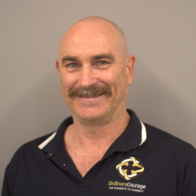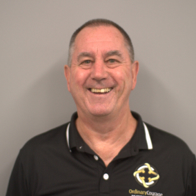If there’s one thing active firefighter Mark Dobson knows after years of fighting some of Australia’s worst bushfires, it’s the value of preparedness before and during bushfire season.
“It really all comes back to preparation – the truth is that the more people are aware and prepared for any sort of disaster, the better they're going to cope with it,” says Mark, who also volunteers as a team manager for Disaster Relief Australia.
While we all hope our bushfire preparedness will never be truly tested, climate change is driving increased frequency and risk of dangerous bushfire conditions.1 It’s essential that property owners are ready for fire season, whether they live in a traditionally bushfire-prone area or in a more urban setting.
In this article, Mark, along with Jim Smith, a veteran firefighter and former Deputy Commissioner of Fire and Rescue NSW, share four occasions when they’ve seen the value of bushfire preparedness play out in real life.
1. The benefits of leaving early
When Mark was part of the crew defending homes in New South Wales’s devastating Blue Mountains fires of 2013, he recalls spending the morning before the fire evacuating residents in the path of the fire front.
It is, he says, a perfect example of why leaving early can actually help firefighters save your home.
“I remember on this one street in the direct path of the fire. We spent around six hours evacuating residents and then spraying this special compressed air foam fire retardant around the homes,” Mark shares.
“The fact that the residents had evacuated allowed us to do our job properly. Without worrying about having to protect their lives – which would have been our first priority – we could focus on doing everything we could to protect their homes. That day, we saved every home on that street.”
Bushfire preparation jobs to do before you leave
The NSW Rural Fire Service has a helpful checklist of things you should do before leaving to help firefighters defend your home.2 These include:
- Shutting off gas mains and/or turning off gas bottles
- Relocating flammable items away from the house
- Blocking drainpipes with socks full of sand and fill gutters with water (don’t forget to remove the blockage once the danger has passed). Do not get on the roof to hose it down
- Closing doors, windows and vents
- Filling baths, sinks, buckets and bins with water
- Soaking towels and rugs and placing them across external doorways
- Moving furniture away from windows.2
2. How being prepared helps the fire service do their job
Having a solid bushfire preparedness plan and listening to advice from your local fire service will pay dividends when you’re faced with an approaching fire, says Jim.
He recalls one occasion where he met two property owners in rural NSW when performing a structural triage, which is the assessment of buildings at risk of burning to enable firefighting resources to be deployed where they’re most effective.3
“One was a farmer who had followed all the advice when preparing his property. He had a good 150m clearance between his place and the bush, he had water tanks and pumps around the house, he had generators – everything you could possibly want,” Jim explains.
“He was wearing all the correct gear – the jeans, the long sleeves and the Akubra hat – and I just went there and told him: ‘You don’t need us, you’re fine. Here’s my number, so if anything does happen, give me a ring, but your place is perfect.’
“I left there and went to another house, and I turned up when the fire was coming along. There were people there, and I guess they were obviously fairly new to the land. They were standing there going: ‘We’ve got our electric water pump, but we’ve lost power and have no phone service.’
“We picked them up, took them out of the area and put a fire engine there, but at the end of the day, that’s the difference with preparation.
“The first guy meticulously knew what he was doing, had everything ready, so when the fire came, had the gear, had everything. Meanwhile, a few properties down, they were still in their shorts and T-shirts, trying to work the electric pump that wasn’t ever going to work,” says Jim.
Their homes and lives would have been at serious risk if fire services hadn’t been able to get the fire engine to the property, he adds.
Structural checks for your property
A well-prepared home is easier to defend, and there are several structural checks and outdoor jobs you can do to help prepare your property for bushfire season. Always ensure any changes meet your local building codes.
The Queensland Fire Department suggests the following tasks,4 but it’s always best to check with your local fire service for their recommendations – especially if you live in a rural or bushfire-prone area.
- Remove leaves, twigs, bark and other debris from gutters and roof. Consider installing gutter guards.
- Install steel wire mesh screens on windows, doors, vents and weep holes.
- Enclose open spaces under decks and floors.
- Direct LPG cylinder relief valves away from your house.
- Inspect and maintain firefighting pumps, generators and water systems.
- Seal gaps in external roofs and cladding.
- Remove flammable items from around your home, such as woodpiles, mulch, boxes, hanging baskets, and outdoor furniture.4
3. Clearing the way for ember defence
When thinking about bushfires, we often think of walls of fire or towering columns of black smoke. In fact, 85% of houses are destroyed without facing direct exposure to flames or significant heat from a bushfire front.5 The danger, says Mark, often comes from embers, which can fly far ahead of the fire itself.
“What events such as the Canberra bushfires and Black Saturday in Victoria have shown us is that embers can be many kilometres ahead of the main fire front,” Mark adds.
“During the Black Summer fires, I recall one semi-rural property in the Blue Mountains that had some paddock land around it,” he says.
“There were trees and shrubs – all those things that are lovely to have when you live in that type of area – but the owners had cleared a good amount of space around the house itself.
“An 80-metre fire front came up over the ridge, and there were embers and spot fires everywhere, but this home was easy for us to protect and save because of that buffer around it.
“If you have a home that backs onto any kind of bushland, national park or even a council park, an important part of preparing your property is to ensure you have clear space so firefighters can do their job.”

How to check your yard for hazards
Even if your house doesn’t directly border bushland, it is still important to check your property for hazards that might make your home vulnerable to ember attack.
According to the CSIRO, the items that you should remove or store away safely ahead of bushfire season include:5
- Nearby trees, including fallen tree limbs, taking caution to ensure any felled vegetation doesn’t damage the home, as this may impact your ability to make a home insurance claim
- Mats
- Gas bottles
- Vegetation-based mulch
- Firewood or outdoor furniture
- Containers of petrol, farm chemicals, paints and solvents or other volatile fuels stored beneath gapped verandas and timber decks.5
4. Working together for bushfire safety
If you live in an urban area, your home’s safety may be just as dependent on the preparation of your neighbours’ homes as your own. A property that isn’t prepared is not only at risk itself but can also present a greater danger to neighbours.6
Jim says during his career, he’s seen many examples of neighbourhoods and communities coming together to ensure each other’s safety, both before and during a fire emergency.
“One that comes to mind is in Alfords Point on Sydney’s south side in December 2002, where residents of one street were members of their local Community Fire Unit,” he shares.
“They were so well prepared as a community because they knew what to expect, they prepared well, and they felt confident because they had a plan about what would happen.
“During the fires in that area, they were getting good communications from us, and they always knew if worst comes to worst, we could get fire resources down there, but because we were talking to them, we knew if there was a problem there or there wasn’t,” Jim explains.
“Community Fire Units make a huge difference, because it makes a community come together, look after themselves, and look after the others in their streets.”
How to get involved
Most states and territories have a volunteer program aligned with their rural fire service. If you’re interested in finding out more about training as a volunteer in your region, we’ve listed contacts for each state and territory below:
- ACT and NSW – Community fire units
- Northern Territory – Northern Territory Fire and Rescue Service
- Queensland – Rural Fire Service
- South Australia – Country Fire Service
- Tasmania – Tasmania Fire Service
- Victoria – Country Fire Authority
- Western Australia – Department of Fire & Emergency Services
The overwhelming advice from both Mark and Jim is that being properly prepared for bushfire season could be the difference between saving or losing your home. Having a bushfire survival plan in place and doing everything possible to prepare your property is essential.
“If you’ve got that survival plan in black and white, you’ve got a logical sequence of what you're going to do.”

“And having your property well prepared for bushfire will give it the best chance of survival and being defensible by firefighters.”
For more expert tips to help you get bushfire ready, visit our you.prepared emergency content hub.
Jim Smith & Mark Dobson
With a combined firefighting history of more than 60 years, Jim Smith and Mark Dobson are leading members of Australia’s firefighting community. Their experience encompasses major bushfire events, including the Canberra Bushfires in 2003, Black Saturday in 2009 and the Black Summer fires of 2019-20. The pair now work together in their respective roles as General Manager and Founder of Ordinary Courage, a consultancy dedicated to providing organisations with the tools to sustain good workplace mental health. Youi is proud to partner with Jim and Mark in the creation of this bushfire preparedness content.
The content in this article has been prepared based on current government and emergency services guidelines and expert advice provided at the time of publishing. This information is subject to change. Please be sure to check for the latest information and always consider your personal circumstances regarding bushfire preparedness and response.
Where you have increased your cover or reduced your excess within 72 hours (or other period noted on your policy schedule) of a flood, storm, hail or bushfire occurring, cover will be limited to the amount that was effective prior to the change. Loss, damage or legal liability caused by, resulting or arising from flood, storm, hail or bushfire during the first 72 hours (or other period noted on your policy schedule) of your policy first being purchased is excluded unless certain conditions apply. Refer to the relevant PDS, TMD and your policy schedule for full T&Cs.
1 Source: Bureau of Meteorology – How weather affects fires
2 Source: NSW Rural Fire Service – Your bush fire survival plan. Leave early, your safest choice
3 Source: Tasmanian State Fire Commission – Bushfire triage for buildings
4 Source: Qld Fire Department – Prepare for bushfire season
5 Source: CSIRO – Preparing your home for bushfire
6 Source: Qld Government – Prepare your home for bushfire season






